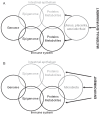Epigenetics and the developmental origins of inflammatory bowel diseases
- PMID: 23248794
- PMCID: PMC3551568
- DOI: 10.1155/2012/526408
Epigenetics and the developmental origins of inflammatory bowel diseases
Abstract
The gut microbiota, the intestinal mucosa and the host immune system are among the large biological networks involved in the development of inflammatory bowel disease (IBD), which includes Crohn disease (CD) and ulcerative colitis (UC). Host genetics and environmental factors can significantly modulate the interactive relationships among these biological systems and influence predilection toward IBD. High monozygotic twin discordance rates and the rapid rise in the prevalence of IBD indicate that environmental influences may be as important or even more important in their pathogenesis than genetic susceptibility. However, the nature and timing of environmental factors critical for inducing IBD remain largely unknown. The molecular mechanisms and the key biological component(s) that may be affected by such factors are also in question. Epigenetic changes, such as DNA methylation (the methylation of cytosines followed by a guanine in CpG dinucleotides) can be modified by environmental influences during finite developmental periods and have been implicated in the pathogenesis of IBD. Mucosal DNA methylation can also react to changes in the commensal microbiota, underscoring the intercalating relationships among the large biological systems involved in gastrointestinal disorders. Therefore, transient environmental influences during specific periods of development may induce critical change(s) in an isolated or concomitant fashion within the intestinal biomic networks and lead to increased susceptibility to IBD. The present review focuses on the emerging paradigm shift considering IBD to originate from critical environmental effects during pre- and postnatal development.
Le microbiote intestinal, la muqueuse intestinale et le système immunitaire de l’hôte font partie des grands réseaux biologiques qui participent à l’apparition des maladies inflammatoires de l’intestin (MII), lesquelles incluent la maladie de Crohn (MC) et la colite ulcéreuse (CU). La génétique de l’hôte et les facteurs environnementaux peuvent moduler de manière significative les relations interactives entre ces systèmes biologiques et influer sur la prédilection vers les MII. D’après les taux de discordance élevés chez des jumeaux monozygotes et l’augmentation rapide de la prévalence des MII, la pathogenèse des influences environnementales serait aussi importante, sinon plus, que la susceptibilité génétique. Cependant, on ne sait pas grand-chose de la nature et du moment d’exposition aux facteurs environnementaux nécessaires pour induire une MII. Les mécanismes moléculaires et les principaux éléments biologiques susceptibles d’être touchés par ces facteurs sont également remis en question. Les changements épigénétiques, tels que la méthylation de l’ADN (méthylation des cytosines suivie par une guanine dans les dinucléotides CpG), peuvent être modifiés par des influences environnementales pendant des périodes précises du développement et contribuer à la pathogenèse des MII. La méthylation de l’ADN muqueux peut également réagir aux changements du microbiote commensal, ce qui fait ressortir les relations intercalantes entre les grands systèmes biologiques participant aux troubles gastro-intestinaux. Ainsi, des influences environnementales transitoires pourraient induire des changements capitaux de manière isolée ou concomitante dans les réseaux biomiques intestinaux, suscitant une plus grande susceptibilité aux MII. La présente analyse porte sur le changement de paradigme émergent selon lequel les MII proviendraient d’effets capitaux de l’environnement pendant le développement prénatal et postnatal.
Figures




Similar articles
-
Determinants of IBD Heritability: Genes, Bugs, and More.Inflamm Bowel Dis. 2018 May 18;24(6):1133-1148. doi: 10.1093/ibd/izy085. Inflamm Bowel Dis. 2018. PMID: 29701818 Free PMC article. Review.
-
Genome-wide peripheral blood leukocyte DNA methylation microarrays identified a single association with inflammatory bowel diseases.Inflamm Bowel Dis. 2012 Dec;18(12):2334-41. doi: 10.1002/ibd.22956. Epub 2012 Mar 29. Inflamm Bowel Dis. 2012. PMID: 22467598 Free PMC article.
-
Challenges for epigenetic research in inflammatory bowel diseases.Epigenomics. 2017 Apr;9(4):527-538. doi: 10.2217/epi-2016-0155. Epub 2017 Mar 27. Epigenomics. 2017. PMID: 28343422 Review.
-
Microbiome-Epigenome Interactions and the Environmental Origins of Inflammatory Bowel Diseases.J Pediatr Gastroenterol Nutr. 2016 Feb;62(2):208-19. doi: 10.1097/MPG.0000000000000950. J Pediatr Gastroenterol Nutr. 2016. PMID: 26308318 Free PMC article. Review.
-
[The Role of the Exposome in the Emergence of Chronic Inflammatory Bowel Diseases].Ther Umsch. 2019 Jan;75(5):261-270. doi: 10.1024/0040-5930/a000998. Ther Umsch. 2019. PMID: 30700238 Review. German.
Cited by
-
Microbiome associations of therapeutic enteral nutrition.Nutrients. 2014 Nov 21;6(11):5298-311. doi: 10.3390/nu6115298. Nutrients. 2014. PMID: 25421531 Free PMC article. Review.
-
From Crypts to Cancer: A Holistic Perspective on Colorectal Carcinogenesis and Therapeutic Strategies.Int J Mol Sci. 2024 Aug 30;25(17):9463. doi: 10.3390/ijms25179463. Int J Mol Sci. 2024. PMID: 39273409 Free PMC article. Review.
-
Proceedings of the 2017 ASPEN Research Workshop-Gastric Bypass: Role of the Gut.JPEN J Parenter Enteral Nutr. 2018 Feb;42(2):279-295. doi: 10.1002/jpen.1121. JPEN J Parenter Enteral Nutr. 2018. PMID: 29443403 Free PMC article. Review.
-
Characterization of Human Colon Organoids From Inflammatory Bowel Disease Patients.Front Cell Dev Biol. 2020 Jun 4;8:363. doi: 10.3389/fcell.2020.00363. eCollection 2020. Front Cell Dev Biol. 2020. PMID: 32582690 Free PMC article.
-
Loss of n-6 fatty acid induced pediatric obesity protects against acute murine colitis.FASEB J. 2015 Aug;29(8):3151-9. doi: 10.1096/fj.14-267690. Epub 2015 Apr 22. FASEB J. 2015. PMID: 25903104 Free PMC article.
References
-
- Molodecky NA, Soon IS, Rabi DM, et al. Increasing incidence and prevalence of the inflammatory bowel diseases with time, based on systematic review. Gastroenterology. 2012;142:46–54. - PubMed
-
- Cosnes J, Gower-Rousseau C, Seksik P, Cortot A. Epidemiology and natural history of inflammatory bowel diseases. Gastroenterology. 2011;140:1785–94. - PubMed
-
- Halfvarson J. Genetics in twins with Crohn’s disease: Less pronounced than previously believed? Inflamm Bowel Dis. 2011;17:6–12. - PubMed
-
- Spehlmann ME, Begun AZ, Burghardt J, Lepage P, Raedler A, Schreiber S. Epidemiology of inflammatory bowel disease in a German twin cohort: Results of a nationwide study. Inflamm Bowel Dis. 2008;14:968–76. - PubMed
Publication types
MeSH terms
Substances
Grants and funding
LinkOut - more resources
Full Text Sources
Other Literature Sources
